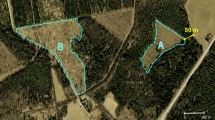Summary
The flight patterns of twenty species of butterflies present in two coniferous woods and one coppiced wood in eastern England were recorded from April to September 1979. The most mobile species were those characteristic of disturbed habitats, with spatially segregated larval and adult habitats, and those butterflies with early successional larval host plants. The least mobile species were those of permanent habitats and those with ubiquitous larval host plants. Flights of poorly vagile species, but not vagile species, were restricted in both coniferous and coppiced woodland, but were shorter in the latter due to the presence of vegetational barriers to flight. Vagile species remained in coppiced areas longer than in areas of coniferous woodland, flights being influenced by the location of larval and adult food resources.
Similar content being viewed by others
References
Baker RR (1969) The evolution of the migratory habit in butterflies (Lepidoptera). J Anim Ecol 38:703–746
Baker RR (1972) Territorial behaviour of the nymphalid butterflies Aglais urticae (L.) and Inachis io (L.). J Anim Ecol 41:453–469
Dethier VG, MacArthur RH (1964) A field's capacity to support a butterfly population. Nature 201:728–729
Dowdeswell WH, Fisher RA, Ford EB (1949) The quantitative study of populations in the Lepidoptera II. Maniola jurtina (L.). Heredity 3:67–84
Dowdeswell WH, Fisher RA, Ford ERS, Ford EB (1940) The quantitative study of populations in the Lepidoptera I. Polyommatus icarus. Rott Ann Eugen 10:123–136
Ehrlich PR (1961) Intrinsic barriers to dispersal in checkerspot butterfly. Science 134:108–109
Ehrlich PR, Gilbert LE (1973) Population structure and dynamics of the tropical butterfly Heliconius ethilla. Biotropica 5:69–82
Gilbert LE, Singer MC (1973) Butterfly ecology. Ann Rev Ecol Syst 6:365–397
Keller EC, Mattoni HT, Sieger MSB (1966) Preferential return of artificially displaced butterflies. Anim Behav 14:197–200
Powell JA (1972) Population expansion and mass movement of Nymphalis californica (Nymphalidae). J Lepid Soc 26:226–228
Scott JA (1975) Flight patterns among eleven species of diurnal Lepidoptera. Ecology 56:1367–1377
Shapiro AM (1970) The role of sexual behaviour in density-related dispersal of pierid butterflies. Am Nat 104:367–372
Singer MC (1972) Complex components of habitat suitability within a butterfly colony. Science 173:75–77
Southwood TRE (1962) Migration of terrestrial arthropods in relation to habitat. Biol Rev 37:171–214
Williams CB (1970) The migration of the painted lady butterfly, Vanessa cardui (Lepidoptera, Nymphalidae) with special reference to North America. J Lepid Soc 24:157–175
Author information
Authors and Affiliations
Rights and permissions
About this article
Cite this article
Shreeve, T.G. Flight patterns of butterfly species in woodlands. Oecologia 51, 289–293 (1981). https://doi.org/10.1007/BF00540617
Received:
Issue Date:
DOI: https://doi.org/10.1007/BF00540617



